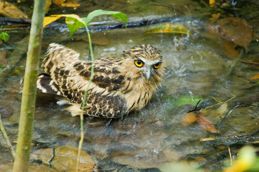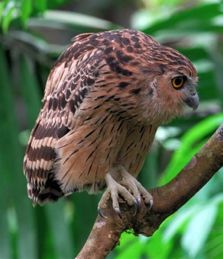During the last few weeks the resident juvenile Buffy Fish Owl (Ketupa ketupu) at Lower Peirce Reservoir had been regularly taking its bath in the shallows of the reservoir (left). It flew into the water either in the morning or in the evening, usually whenever it was hot and sunny. Did it bathe at night? It might but was there anyone around to witness it bathing in the dark?
According to Johnny Wee who is familiar with this stretch of the forest, he used to regularly see a pair of Buffy Fish Owls around. On and off he would witness one bathing or fishing at around 9.00 am. The pair disappeared for about a year but returned with a juvenile during the second half of February 2007 (below). He used to see the adults feeding the juvenile.
This juvenile owl has now been seen feeding itself. It was even photographed feeding on a snail.
In an earlier post, a pair of Spotted Wood-owls (Strix seloputo) at Swiss Club Road used to bathe every morning if rain during the night had left puddles in the Turf Club Car Park.
Now why does an owl bathe?
Like most non-aquatic birds, an owl takes a bath once in a while to clean its feathers. It usually stands in shallow water, either at the edge of a lake or stream and flaps its wings to splash water over the body. The bird may sometimes immerse its body in deeper water. Or even take a plunge bath – flying at a low angle and splashing briefly in the water.
And after a bath the owl will vigorously shakes off the water from its body, preens its feathers and sometimes also dries itself in the sun.
Preening will rearrange the barbs and barbules of the feathers. During preening, oil from the preen gland located at the base of the tail will help keep the feathers from becoming brittle. The oil is also believed to have fungicidal and bactericidal properties.
Bathing may also help remove external parasites, mainly lice.
Top image by Allan Teo, bottom image by Johnny Wee.











3 Responses